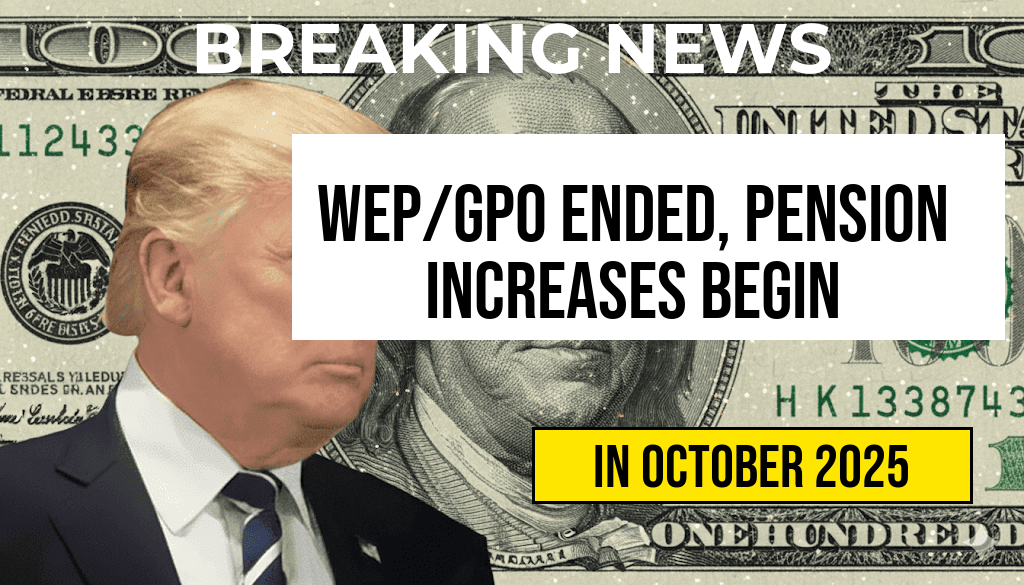The long-standing WEP (Windfall Elimination Provision) and GPO (Government Pension Offset) policies that have historically limited the retirement benefits of certain public servants have officially ended, leading to significant financial gains for teachers and firefighters across the country. As a result, thousands of retirees now qualify for monthly pension increases of up to $500, providing much-needed relief and financial stability. This legislative change, enacted after years of advocacy and debate, aims to correct disparities in retirement benefits for public employees who also earned Social Security credits elsewhere. The reforms are expected to impact a broad demographic, particularly those who worked multiple jobs or transitioned from private sector roles into public service, and signal a shift toward more equitable pension policies nationwide.
Background on WEP and GPO Policies
The Windfall Elimination Provision (WEP) and Government Pension Offset (GPO) are federal rules that reduce Social Security benefits for specific public employees. Established in the 1980s, these policies were designed to prevent double-dipping by individuals who receive pensions from government jobs and also qualify for Social Security benefits based on other employment. However, critics argued that the formulas used often resulted in disproportionately large reductions, especially impacting teachers, firefighters, and other public service workers who contributed to both systems during their careers.
Legislative Changes and Their Impact
Recent legislative reforms have abolished the WEP and GPO provisions, allowing affected retirees to receive the full amount of their Social Security benefits without reductions. The change was part of the broader SECURE Act 2.0, signed into law earlier this year, which aimed to enhance retirement security for millions of Americans.
Under the new rules, teachers and firefighters who previously saw their Social Security benefits cut by hundreds of dollars each month will now receive the full benefit amount they earned through their contributions and work history. The reforms are projected to add an estimated $4 billion annually to the retirement income of thousands of public employees, providing a meaningful boost to their financial well-being.
Details of Monthly Pension Increases
| Occupation | Previous WEP/GPO Impact | New Monthly Increase | Total Estimated Monthly Benefit |
|---|---|---|---|
| Public School Teachers | $200 – $400 reduction | Up to $400 – $500 | $2,000 – $3,500 |
| Firefighters | $150 – $350 reduction | Up to $300 – $500 | $2,200 – $3,600 |
Eligibility Criteria
- Retired public school teachers and firefighters who contributed to Social Security through other employment.
- Individuals who experienced reductions due to the WEP or GPO prior to the legislation change.
- Recipients of full or partial pensions from government agencies that previously triggered benefit offsets.
Broader Implications for Public Sector Retirement Policies
The elimination of WEP and GPO provisions reflects a broader effort to enhance fairness in public retirement systems. Advocates argued that these policies unfairly penalized dedicated public servants, many of whom relied on Social Security benefits to supplement their pensions. The reforms also align with ongoing discussions about retirement equity, especially as public employee demographics shift and the workforce ages.
Some experts note that the policy change could influence future legislative efforts to improve retirement security for other categories of workers, including those in local government roles or part-time public service positions. The move also underscores a growing recognition of the need for policy adjustments that reflect the realities of modern careers involving multiple employment streams.
Retirees’ Reactions and Perspectives
Many retirees have expressed relief and gratitude for the change, citing the added financial stability as a significant quality-of-life improvement. “This adjustment means I can finally breathe easier, especially now that inflation is affecting everything around us,” said a retired firefighter from Ohio. Teachers’ associations and public employee unions have also lauded the decision, emphasizing its importance in acknowledging the contributions of public service workers.
While some retirees will see immediate benefits, others may need to update their benefit calculations with the Social Security Administration to reflect the new policy. Officials recommend contacting local SSA offices or visiting their website for personalized assessments and guidance.
Looking Ahead
The end of WEP and GPO effects marks a significant shift in public pension policies, with potential ripple effects across state and local jurisdictions. States with large populations of retired teachers and firefighters are expected to see increased economic activity as more retirees experience improved financial health. As federal policies evolve, public employees may also gain greater advocacy and representation in shaping future retirement benefits.
For additional information on Social Security policies and retirement planning, visit Wikipedia’s Social Security page or consult the Social Security Administration’s official guidelines.
Frequently Asked Questions
What is the reason for the end of the WEP/GPO pension calculations?
The WEP/GPO calculations have ended due to recent legislative changes aimed at providing monthly pension increases to teachers and firefighters.
Who is eligible for the monthly pension increases?
Eligible teachers and firefighters who are receiving retirement pensions can now receive monthly increases of up to $500.
How much can teachers and firefighters expect to receive in pension increases?
Teachers and firefighters are expected to receive monthly pension increases of up to $500, depending on their specific pension plan and years of service.
When did the pension increases take effect?
The monthly pension increases were implemented starting from the most recent payment cycle, following the legislative changes that ended the WEP/GPO calculations.
How can recipients verify their new pension amounts?
Recipients can verify their new pension amounts by checking their monthly statements or contacting their pension plan administrators.

Leave a Reply